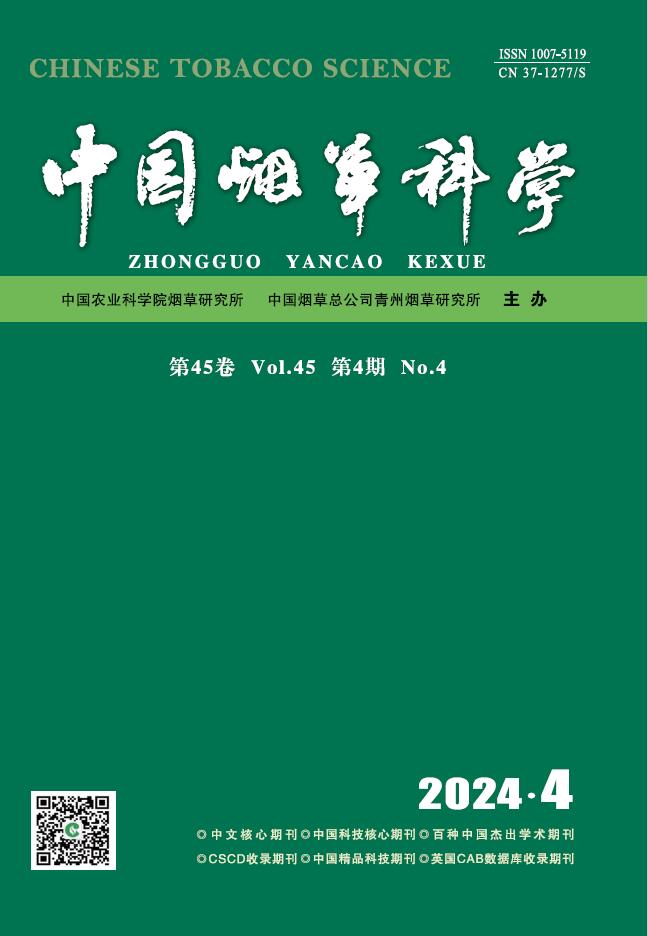排序方式对暗烤烟和白利烟中烟草特异性亚硝胺含量的影响
引用次数: 0
摘要
烟草特异性亚硝胺(TSNAs)是已知的在烤烟中的致癌物。它们主要是在烘烤过程中产生的,但田间的农艺做法以及烘烤后的处理做法也可能影响TSNA水平,特别是如果烘烤后的叶子在高湿度下储存。在固化后和市场准备期间,固化的叶子必须柔软,以避免破损。理想情况下,这是经过一段时间的潮湿天气期间,叶片吸收水分,并进入秩序或情况。通常情况下,干燥后的天气会持续很长一段时间,种植者就会采取人工命令的方式,取下足够数量的烟草来种植几天,在这段时间里,烟草会变大。这种人为排序在短期储存期间对tsna的影响尚不清楚。在肯塔基州的两个地点,每3年进行一次田间试验,以评估几种排序方法在暗风干和白肋烟类型中TSNA的积累。处理方法包括自然排序和蒸汽和喷雾的变体,这两种方法都是常用的人工排序方法。在普林斯顿地区,样品在排序处理完成后24小时内采集。在列克星敦,样品在下架时、下订单后和批量生产14天后依次采集。不同排序方法的总TSNA含量差异有限且不一致,且TSNA水平不受叶片膨胀过程中水分含量的影响。在取下和堆积之间的24小时内,TSNAs显著增加,这无法解释。我们的结论是,在肯塔基州,种植者应该使用最适合他们生产系统的订购方法,但在温暖的气候条件下,情况可能并非如此。本文章由计算机程序翻译,如有差异,请以英文原文为准。
Effect of Ordering Method on Tobacco-Specific Nitrosamines (TSNAs) Content in Dark Air-Cured and Burley Tobacco
Tobacco-specific nitrosamines (TSNAs) are known carcinogens in cured tobacco. They are produced primarily during the curing process, but agronomic practices occurring in the field as well as handling practices after curing may also influence TSNA levels, particularly if cured leaf is stored at high moisture. After curing and during market preparation, the cured leaf must be supple to avoid breakage. Ideally, this is after a period of wet weather during which the leaf absorbs moisture and comes into order or case. Often the weather remains dry for long periods after curing, and growers resort to artificial ordering to take down a sufficient amount of their crop to work on for several days, during which time the tobacco is bulked. The effect of this artificial ordering on TSNAs during short-term storage is not known. Field experiments were conducted in each of 3 years at two locations in Kentucky to evaluate TSNA accumulation following several ordering methods in dark air-cured and burley tobacco types. Treatments included natural ordering and variants of steaming and misting, which are both commonly used artificial ordering methods. At the Princeton location, samples were taken within 24 hr after the ordering treatments were done. In Lexington, samples were taken sequentially at takedown, after ordering, and after 14 d in the bulk. There were limited and inconsistent differences in total TSNAs between methods of ordering, and the TSNA levels were not affected by the moisture content of the leaf during bulking. There was a significant increase in TSNAs in the 24-hr period between takedown and bulking, which cannot be explained. We conclude that, in Kentucky, growers should use ordering methods that are best suited for their production system, but this may not be the case in warmer climates.
求助全文
通过发布文献求助,成功后即可免费获取论文全文。
去求助
来源期刊

中国烟草科学
烟草
自引率
0.00%
发文量
3722
期刊介绍:
Chinese Tobacco Science is an academic scientific journal (bimonthly) under the supervision of the Ministry of Agriculture and Rural Affairs of the People's Republic of China, and sponsored by the Tobacco Research Institute of the Chinese Academy of Agricultural Sciences and the Qingzhou Tobacco Research Institute of China National Tobacco Corporation. It was founded in 1979 and is publicly distributed nationwide. The journal mainly publishes academic papers on scientific research results, new production technologies, and modern management in my country's tobacco science research and tobacco production technology. In addition, it also publishes forward-looking review articles in the field of tobacco research. There are columns such as tobacco genetics and breeding, cultivation technology, modulation and processing, physiology and biochemistry, plant protection, review or monograph, quality chemistry, etc.
 求助内容:
求助内容: 应助结果提醒方式:
应助结果提醒方式:


